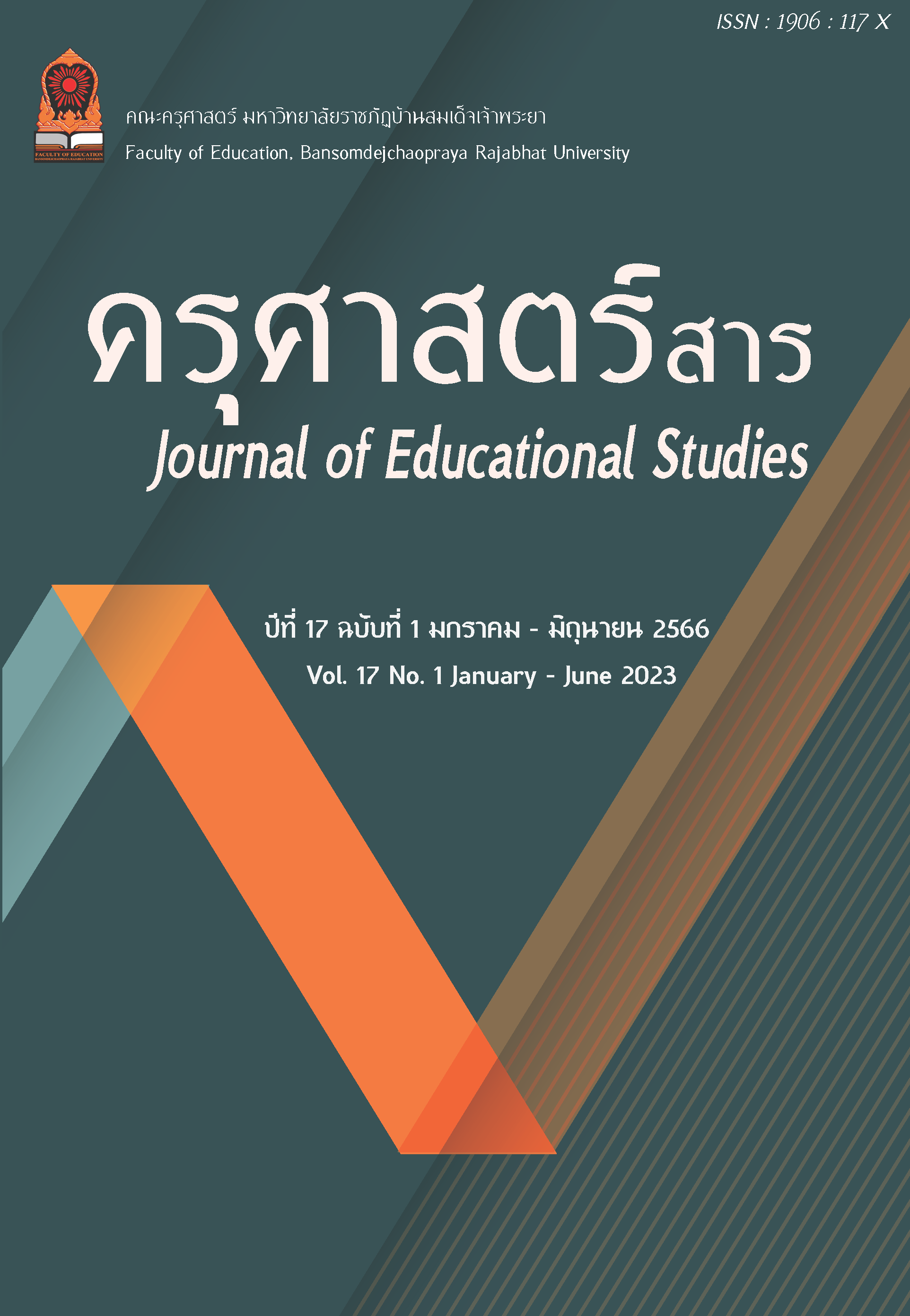Development of indicators of student’s self-directed learning technique with the confirmatory factor analysis model
Keywords:
Development, Self-directed learning, Confirmatory factor analysisAbstract
The research on the Development of indicators of student’s self-directed learning technique with the confirmatory factor analysis model. aimed to 1) create and develop student self-directed learning indicators and 2) examine the consistency between the linear structural relationship model of student’s self-directed learning indicators developed by the researcher and the empirical data using the confirmatory factor analysis model. The sample group used in this research was 380 undergraduate students studying at Bansomdejchaopraya Rajabhat University during the first semester of the academic year 2022. A stratified random sampling method was also applied. The research equipment consisted of a questionnaire with 2 parts including the student status information and a questionnaire measuring self-directed learning with a 5-level estimation scale. The collected data were analyzed using descriptive and reference statistics were Pearson correlation coefficient analysis and Confirmatory factor analysis.
The research results revealed as follows:
1. The reliability value of self-directed learning was 0.88; the standard error was 0.22; the mean was 3.92; the standard deviation was 0.54; the skewness was -0.25; and the kurtosis was -0.12.
2. The correlation coefficient between the self-directed learning indicators and the 8 main factors was positive with a statistically significant level of 0.01, ranging from 0.20 to 0.58.
3. The self-directed learning indicators and the 8 key factors were consistent with the empirical data according to the condition/acceptance level with the confirmatory factor analysis model
Downloads
References
กมลรัตน์ โยธานันต์. (2562). การวิเคราะห์องค์ประกอบเชิงยืนยันของตัวบ่งชี้ปัจจัยส่วนผสมทางการตลาดที่ส่งผลต่อการเลือกใช้บริการรับส่งพัสดุภัณฑ์. วารสารบริหารธุรกิจศรีนครินทรวิโรฒ ปีที่ 10, ฉบับที่ 1 (ม.ค.-มิ.ย. 2562), หน้า 30-43.
ชำนาญ ปาณาวงษ์. (2563). ระเบียบวิธีวิจัยเชิงคุณภาพ : จากแนวคิดทฤษฎีสู่การปฏิบัติ. พิษณุโลก : สำนักพิมพ์มหาวิทยาลัยนเรศวร.
ณัฐวรา จันทร์เอี่ยม. (2562). ประสิทธิผลและความพึงพอใจในการเรียนรู้ด้วยตนเองผ่านสื่อการสอนเสมือนจริง ในการดูแลแผลกดทับของนิสิตพยาบาลศาสตร์ มหาวิทยาลัยศรีนครินทรวิโรฒ.วารสารศรีนครินทรวิโรฒวิจัยและพัฒนา (สาขามนุษยศาสตร์และสังคมศาสตร์) ปีที่ 11, ฉบับที่ 22 (ก.ค.-ธ.ค. 2562), หน้า 45-56.
นพมาศ ปลัดกอง, ปิยดา สมบัติวัฒนา และนริสรา พึ่งโพธิ์สภ. (2562). การพัฒนาการเรียนรู้ด้วยการนำตนเองของผู้เรียนในระบบการศึกษาทางไกล โดยใช้รูปแบบการจัดการเรียนรู้ด้วยเทคนิคนั่งร้านเสริมเรียนรู้.ปริญญานิพนธ์ (ปร.ด. (จิตวิทยาประยุกต์)) : มหาวิทยาลัยศรีนครินทรวิโรฒ.
ยะยา ยุทธิปูน และมารุต พัฒผล. (2563). การพัฒนารูปแบบการจัดการเรียนรู้ที่เสริมสร้างความเชื่อมั่นในการสื่อสารภาษาอังกฤษและทักษะชีวิต สำหรับผู้เรียนระดับมัธยมศึกษาตอนต้น.ปริญญานิพนธ์ (ปร.ด.(การวิจัยและพัฒนาหลักสูตร)) : มหาวิทยาลัยศรีนครินทรวิโรฒ.
สำนักงานสภานโยบายการอุดมศึกษา. (2562). พระราชบัญญัติการอุดมศึกษา พ.ศ. 2562 . กองกฎหมายการศึกษาและวัฒนธรรม สำนักงานคณะกรรมการกฤษฎีกา
สำนักงานสภานโยบายการอุดมศึกษา. (2562). พระราชบัญญัติสภานโยบายการอุดมศึกษา วิทยาศาสตร์ วิจัยและนวัตกรรมแห่งชาติพ.ศ. ๒๕๖๒. เล่ม ๑๓๖ ตอนที่ ๕๗ ก.
สินธะวา คามดิษฐ์. (2556). ระเบียบวิธีการวิจัยเบื้องต้น. กรุงเทพฯ : มหาวิทยาลัยธุรกิจบัณฑิต.
Enriquez, Juan. (2001). As the Future Catches You. New York: Tuttle-Mori.
Posner, M. I. (1993, October 29). Seeing the mind. Science, 262, 673 –674.
Downloads
Published
How to Cite
Issue
Section
License

This work is licensed under a Creative Commons Attribution-NonCommercial-NoDerivatives 4.0 International License.
บทความที่ได้รับการตีพิมพ์เป็นลิขสิทธิ์ของคณะครุศาสตร์ มหาวิทยาลัยราชภัฏบ้านสมเด็จเจ้าพระยา
ข้อความที่ปรากฏในบทความแต่ละเรื่องในวารสารวิชาการเล่มนี้เป็นความคิดเห็นส่วนตัวของผู้เขียนแต่ละท่านไม่เกี่ยวข้องกับมหาวิทยาลัยราชภัฏบ้านสมเด็จเจ้าพระยา และคณาจารย์ท่านอื่นๆในมหาวิทยาลัยฯ แต่อย่างใด ความรับผิดชอบองค์ประกอบทั้งหมดของบทความแต่ละเรื่องเป็นของผู้เขียนแต่ละท่าน หากมีความผิดพลาดใดๆ ผู้เขียนแต่ละท่านจะรับผิดชอบบทความของตนเอง



